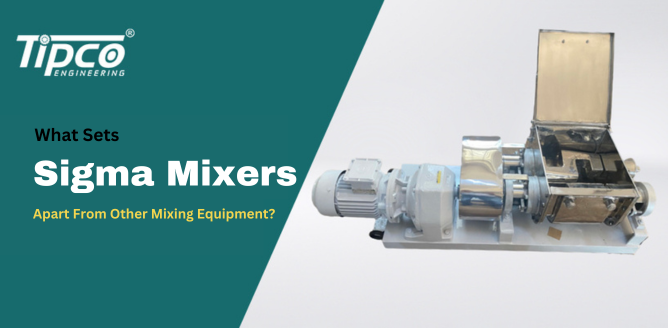Sigma mixers are often referred to as “Universal Mixers” because of their exceptional adaptability. They are capable of handling batches of materials with viscosities ranging from incredibly thin to incredibly thick. The universal kneading and mixing machine’s rectangular trough at the base curves to create two half-cylinders. This is the machine’s basic construction. It can be controlled by using the proper gearing on either the top or bottom of the trough. It also features two horizontally aligned blades. The blades cover the entire surface area of the half-cylinder with each revolution. The batch experiences both lateral and transverse motion as a result of their different and uneven rotational rates.
The blades will thoroughly mix every particle in the batch because of the little space between them and the trough. This occurs as a result of the batch’s continual motion caused by the blades spinning through it. The saddle, sidewalls, and blades are blending and crushing the material at the same time, which results in a lot of kneading. Dry grains and very stiff plastic masses can be handled with ease by sigma mixers.
The five main parts of Tipco Engineering Sigma Mixer machines are the kneading section, base section, hydraulic system, gearbox system and electric control system.
The control station of the hydraulic system allows the user to fully customise the opening and shutting operations of the massive cylinder. With complete user control over all parameter details, the system is both dependable and convenient. Motors, reducers, and gear units make up the gearbox system, which is based on the matching type of kneading machine.
The Qualities Sigma Mixer
- There is a customisable model available with a 1,000-gallon working capacity.
- In addition, depending on your production needs, you can load and unload using tilting or fixed bottom valve discharge units.
- You can buy models of extruders with a single screw.
- the layout of a heated or cooled jacketed trough.
- The drive is not connected in any way to the blade arm; it has distinct ratios and rotation speeds.
- The bowl’s troughs held two sigma-shaped, horizontally orientated blades.
- idea predicated on pressure or vacuum.
- An extraordinarily sturdy steel base supports the entire mixer, ensuring vibration-free and quiet operation.
- construction materials with explosion resistance.
Sigma Blade Mixers in Systems: An Overview
When the mixer is in use, the product is usually added through the top of the container, filling it to a capacity of forty to sixty-five percent of its total content. The blades are ensured to rotate by heavy-duty drive systems, which usually consist of a motor, gearbox, couplings, and gears. The tip of the Sigma mixer usually has a maximum speed of sixty metres per minute.
Apart from ambient temperature or a regulated environment, combining at room temperature is also possible. By placing jackets on the mixer troughs, hot or cold material can pass through the Tipco Engineering Industrial Sigma Mixer Machines, allowing the internal temperature of the mixer to be accurately adjusted. The material can be released by utilising the screw or extruder located in the lower section between the two trough compartments, tilting the mixer container, or turning the bottom discharge valve. Any of these discharge configurations that are available can be connected to the mixer.
The tilting discharge is the most common type of this arrangement. A mechanical or hydraulic system can automatically tilt the container, or it can be configured such that a person can tilt it. There is a choice between the two setups.
For materials with lower viscosity, the bottom discharge valve can be installed on the mixer trough. In order to eliminate or greatly reduce the appearance of any pockets of dead or unmixed material, the valve’s profile should ideally match the mixer through flush.
Applications of Sigma Mixers
Tipco Engineering Numerous tasks, such as kneading, crushing, stirring, curing, re-polymerization, and high viscosity and high elastic-plastic materials, can be accomplished with sigma mixers. Excellent kneading efficiency, reliable mixing, and the absence of dead ends are the advantages of utilising Sigma’s kneading machine.
The functionality and style of the new Sigma mixer are becoming more versatile. In industrial contexts, it is a very effective machine that is taking the place of many outdated manufacturing techniques.
Also read: What is a Mixing Machine and Its Types?

Leave a comment